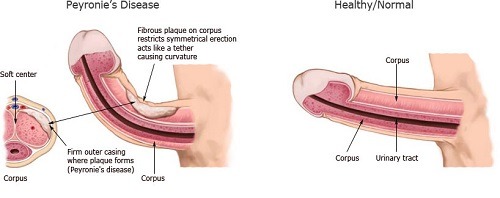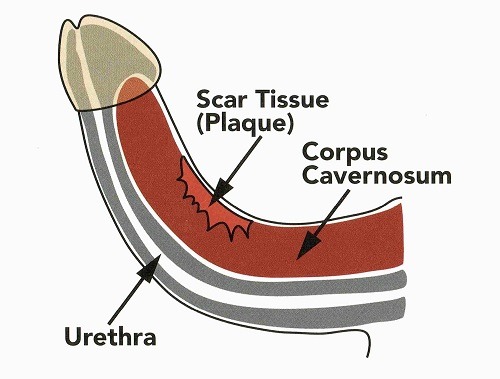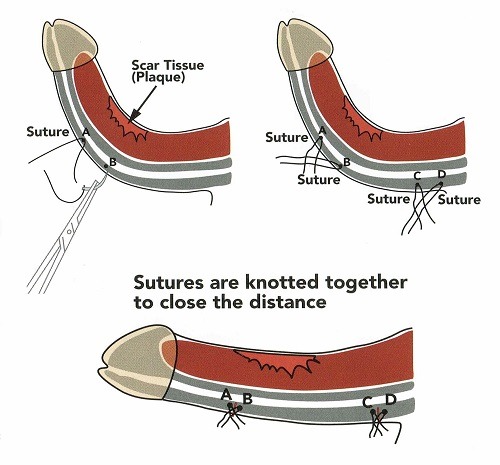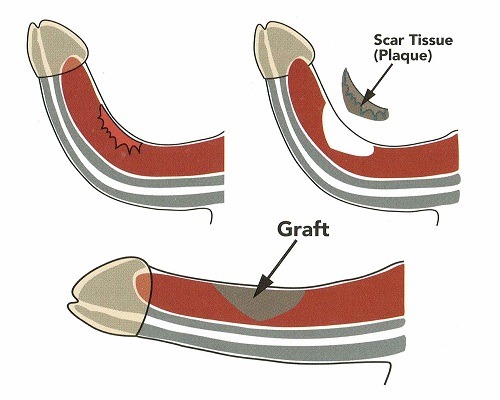Peyronie’s Disease is a condition marked by penile curvature, indentation and loss of penile length upon erection. This can be with or without pain. The penis deformity is caused by plaque formation, which is a thick, inelastic scar. This thick, inelastic scar can cause the penis to curve upwards, downwards, or sideways.
How to Diagnose Peyronie’s Disease
These penile abnormalities can occur in males of any age but are most prevalent in men in their 50s. Up to 90 per cent of men with Peyronie’s Disease also experience erectile dysfunction.
To understand what Peyronie’s disease looks like, the penile curvature should be observed.
The formation of scar tissue on one side of the penis shortens that respective side of the penis, resulting in a curvature, i.e. if the scar tissue is on the right side of the penis, the right side will become slightly shortened, creating a pull of the penis to the right. In this article, we have included Peyronie’s disease pictures for reference.

If you’re wondering how to know if you have Peyronie’s Disease, there can be different tests conducted. A physical exam is usually enough to find scar tissue in the penis and diagnose Peyronie’s Disease. However, other conditions can sometimes cause similar symptoms, so it’s important to rule them out.
The following tests may be used to diagnose Peyronie’s Disease and determine exactly what is causing your symptoms:
1. Physical examination
Your physician will palpate your penis when it is not erect to determine the location and quantity of scar tissue (American Urological Organization, 2015). Additionally, they may measure the length of your penis. This initial measurement helps detect whether the penis has shrunk if the problem worsens.
Your doctor may also request that you bring home photographs of your erected penis. This can detect the degree of curvature, the location of scar tissue, and other characteristics that may aid in determining the optimal treatment method.
2. Other tests
Your physician may prescribe an ultrasound or other procedures to evaluate your erect penis. You will likely receive an injection directly into the penis to erect it before testing.
Ultrasound is the most common diagnostic method for penile problems. They provide images of soft tissues using sound waves. Moreover, these examinations can detect scar tissue, blood flow to the penis, and other issues.
What are Peyronies Disease Symptoms?
The signs and symptoms of Peyronie’s Disease may manifest suddenly or develop gradually. These are the most prevalent indications and symptoms or signs of erectile tissue damage:
- A bend or curvature in the penis: Your penis may bend upwards, downwards, or to the side.
- Scar Tissue: The scar tissue linked with Peyronie’s Disease (called plaque) can be felt as flat lumps or a band of hard tissue under the skin of the penis.
- Penis constriction (sometimes referred to as “hourglassing”): In some men with Peyronie’s Disease, the erect penis may exhibit constriction, indentations, or an hourglass-like look with a tight, thin band around the shaft (Martinez et al., 2012).
- Erectile dysfunction or difficulty: Men with Peyronie’s Disease may experience difficulty achieving or sustaining an erection. However, men frequently experience erectile dysfunction prior to the onset of Peyronie’s disease symptoms.
- Painful erections or sex-related suffering: You may experience penile discomfort with or without an erection.
- Shortening of the penis: As a result of Peyronie’s illness, your penis could become shorter.
Knowing about Peyronie symptoms can help you pinpoint the problem faster and seek professional help promptly. It’s important to catch Peyronie’s disease in its early stages to improve your outcomes.
What causes Peyronie’s Disease?
Peyronie’s Disease causes are not well understood. In most cases, the disease results from inflammation and plaque formation after repeated trauma to the penis, most commonly occurring during sexual intercourse. However, this is not always the case.
Although there is still a dark cloud surrounding the cause of Peyronie’s disease, it is crucial to understand its symptoms, stages and available treatments.
Stages of Peyronie’s Disease
Urologists divide Peyronie’s Disease into two stages: the acute stage and the chronic stage (Martinez et al., 2012).
During both stages, a bent or curved penis may interfere with sexual activity. Concurrently, patients may also experience Erectile Dysfunction.
Peyronie’s Disease often develops over the course of six months. During this period, it should be monitored frequently so that the right treatment for its current stage can be administered.
First Stage: The Acute Phase
Plaque begins to form in the penis. It gradually expands in size and develops curvature. In this stage, the plaque will be softer and more malleable. During the first few months of the acute phase, patients may not notice a change in their penis.
Patients will typically suffer pain or discomfort, a bent penis and a localised hardness or lump.
Second Stage: The Chronic Phase
The plaque is fully formed and rigid during the chronic phase, and the discomfort has typically subsided. The blood veins surrounding the affected area are clogged with microscopic plaques, causing the penis to bend during erection. In most cases, the patient will experience partial erectile dysfunction, a reduction of circumference and length, and a softening of the penis tip.
What is the impact of having Peyronie’s Disease?
Individuals with Peyronie’s Disease are at risk for the following conditions:
Penile Deformity
- Resulting in an indentation, narrowing, or loss of length
- Can interfere with the ability to engage in sexual activity and penetration
Penile Dysfunction
- Peyronie’s Disease is associated with a reduction in rigidity, or hardness, of erections.
- Correction of the curvature rarely leads to correction of erectile dysfunction.
- If erectile dysfunction coexists with Peyronie’s Disease, treatment options exist that will correct both problems.
- This condition has been recognised to affect a man’s psyche markedly, including causation of depression and anxiety disorders. Appropriate diagnosis and treatment require the help of an experienced medical professional
Understanding the impact and side effects of Peyronie’s Disease is crucial for patients seeking to manage the condition effectively.
What Treatment Options Are There For Peyronie’s Disease?
Peyronie’s disease treatments aim to maintain or regain sexual function by straightening the penis. How long it takes to cure Peyronie’s Disease depends on several factors including, but not limited to, degree of penile curvature, the severity of penile shortening, and the presence of penile narrowing, and whether erectile dysfunction is present.
1. Medications
Several oral treatments have been tested to treat Peyronie’s Disease, but their efficacy has not been consistently demonstrated, and they are not as successful as surgery (Martinez et al., 2012).
Injecting medicines directly into the penis may lessen the curvature and pain associated with Peyronie’s Disease in certain individuals. A local anaesthetic may be administered to prevent pain during injections depending on the treatment.
If you undergo one of these therapies, you will likely need several injections over several months. You may also use injection medications together with oral medications or traction treatments.
2. Oral Drugs
Pentoxifylline (Trental) is often the first medicine that doctors prescribe to help straighten the penis. You have to take the pill for a few months to see if it will work.
Some doctors prescribe vitamin E supplements or a form of potassium called para-aminobenzoate, but there is little evidence that these work (American Urological Organization, 2015).
In men with Peyronie’s Disease who also have some erectile dysfunction, drugs to treat ED may help.
3. Penile Injections
Your doctor may suggest injecting a drug into the penis to break up the scar tissue.
Verapamil is a drug that some doctors use. Studies show that it can help many men feel less pain and lessen the curve.
Collagenase clostridium histolyticum (Xiaflex) is another drug used to treat Peyronie’s that is given by injection.
4. Other Treatments
Iontophoresis is another treatment for penile curvature. It is a non-invasive procedure that uses an electric current to give verapamil and steroid through the skin. However, available research regarding penile curvature and erectile function reveals contradictory outcomes (Babu & Kayes, 2020).
Several non-drug therapies for Peyronie’s Disease are also under investigation (García-Gómez et al., 2020; Miner & Seftel, 2013). However, information about their efficacy and potential adverse effects is inadequate. The use of powerful sound waves (shock wave therapy) to break up scar tissue (Hauck & Weidner, 2007), stem cells, platelet-rich plasma, and radiation therapy are examples of these treatments.
There are many Peyronie’s Disease medical procedures that offer various options to reduce symptoms and improve quality of life. Consulting with a healthcare provider can help determine the most suitable procedure based on the severity of your condition and individual needs.
Peyronie’s Disease Surgery Options
There are three techniques to make the penis straight (American Urological Organization, 2015):
1. Shortening the longer side of the penis to create equal length on both sides. Although shortening may occur, the amount of shortening is typically no more than 1-2 cm. This procedure is utilised for less severe cases of Peyronie’s Disease

2. Scar tissue is cut or partially removed on the shorter side. After removing this tissue, the defect is filled with a graft. The resultant penile length is approximately equivalent to the longer side of the penis. This operation is reserved for men with severe deformity and no erectile dysfunction.

3. For men with erectile dysfunction and Peyronie’s Disease, a penile prosthesis may be placed, followed by penile straightening with manual modelling. Want to know more about Penile prostheses and how they work? Click here.

Peyronie’s Disease Before and After Surgery
Understanding Peyronie’s Disease and how surgery can help is important for anyone considering treatment. Here’s a simple guide on what to expect before and after surgery:
Before Surgery
1. Symptoms and Challenges:
- Penile Curvature: Noticeable bending of the penis, especially during erections.
- Pain: Pain in the penis, mainly during erections or sexual activity.
- Erectile Dysfunction: Trouble getting or keeping an erection due to the scar tissue.
- Mental Impact: Feelings of anxiety, depression, and stress in relationships because of changes in sexual function and appearance.
2. Everyday Life:
- Sexual Activity: Difficulty with sexual performance and satisfaction because of pain and curvature.
- Self-Esteem: Lower self-confidence and concerns about sexual attractiveness.
After Surgery
1. Physical Improvements:
- Reduced Curvature: Straighter penis, improving both function and appearance.
- Pain Relief: Less or no pain, especially during erections.
- Restored Function: Better ability to get and keep an erection, leading to more satisfying sexual experiences.
2. Quality of Life:
- Improved Sexual Health: More confidence and enjoyment in sexual activities.
- Better Mental Health: Less anxiety and depression, leading to a happier life.
- Stronger Relationships: Better intimacy and communication with partners due to improved sexual function and confidence.
3. Recovery and Care:
- Healing Process: Knowing what to expect during recovery, from immediate care after surgery to long-term follow-up.
- Ongoing Care: Following medical advice, attending follow-up appointments, and maintaining a healthy lifestyle to support recovery and prevent complications.
Surgery for Peyronie’s Disease can greatly improve symptoms and quality of life. By reducing penile curvature, relieving pain, and restoring erectile function, surgery helps men regain confidence and enjoy a more satisfying life. Understanding the Peyronie’s Disease surgery before and after helps patients make informed decisions and prepare for a smooth recovery.
Peyronie’s Surgery Recovery Time
Recovering from surgery for Peyronie’s Disease involves several stages, each crucial for ensuring the best possible outcome.
1. Immediate Post-Surgery Phase (First 1-2 Weeks)
- Hospital Stay: Depending on the type of surgery performed, you may need to stay in the hospital for a day or two. This allows for close monitoring and immediate management of any complications.
- Pain Management: Pain and discomfort are common during the first few days. Pain relievers and anti-inflammatory medications will be prescribed to manage this.
- Wound Care: Keeping the surgical site clean and dry is essential to prevent infection. Follow your doctor’s instructions for wound care meticulously.
2. Early Recovery Phase (Weeks 2-6)
- Rest and Limited Activity: It’s important to rest and avoid strenuous activities, including heavy lifting and vigorous exercise. Light activities and walking are encouraged to promote blood flow and healing.
- Swelling and Bruising: Swelling and bruising around the surgical site are normal and should gradually improve. Using ice packs as recommended can help reduce swelling.
- Follow-Up Appointments: Regular follow-up visits with your surgeon are crucial to monitor healing progress and address any concerns promptly.
3. Intermediate Recovery Phase (Weeks 6-12)
- Gradual Return to Normal Activities: You can slowly return to more regular activities, but it’s essential to listen to your body and not rush the process.
- Physical Therapy: Some patients may benefit from physical therapy or specific exercises to improve penile function and reduce any residual curvature.
- Monitoring for Complications: Be vigilant for signs of complications such as infection, excessive pain, or issues with urination, and report these to your doctor immediately.
4. Long-Term Recovery (3-12 Months)
- Sexual Activity: Resuming sexual activity is usually possible after about 6-8 weeks, but this can vary. Your doctor will provide specific guidance based on your recovery progress.
- Final Results: The final results of the surgery, including improvements in curvature and erectile function, may take several months to become fully apparent.
- Ongoing Care: Continue to attend follow-up appointments and maintain communication with your healthcare provider to ensure optimal recovery and address any long-term issues.
By understanding the stages of recovery and following medical advice, patients can optimise their healing process and achieve the best possible outcomes from Peyronie’s surgery.
Frequently Asked Questions
Peyronie’s Disease Treatment in Australia
If you’re struggling with Peyronie’s Disease, know that there are many effective treatments available to help you. Depending on how severe your condition is, these options include non-invasive therapies or, if needed, surgical solutions. The goal is to find the right treatment that fits your needs and helps you feel better. Don’t worry. You’re not alone in this. We are here to help you.
As such, if you’re experiencing symptoms of Peyronie’s Disease, early intervention is key to effective treatment. At Katelaris Urology Clinic, Dr. Katelaris and his team offer personalised care and advanced treatment options tailored to your specific needs. Don’t let Peyronie’s Disease control your life. Contact Katelaris Urology Clinic today to schedule a consultation and take the first step toward recovery.
References:
American Urological Association. (2015). Peyronie’s Disease. Peyronie’s disease guideline – american urological association. Retrieved May 23, 2022, from https://www.auanet.org/guidelines/guidelines/peyronies-disease-guideline
Babu, A., & Kayes, O. (2020). Recent advances in managing Peyronie’s disease. F1000Research, 9, 381. https://doi.org/10.12688/f1000research.20557.1
Bilgutay, A. N., & Pastuszak, A. W. (2015). Peyronie’s disease: A review of etiology, diagnosis, and management. Current Sexual Health Reports, 7(2), 117-131. https://doi.org/10.1007/s11930-015-0045-y
García-Gómez, B., García-Rojo, E., Alonso-Isa, M., Medina-Polo, J., Santos-Pérez de la Blanca, R., Justo-Quintas, J., Parnham, A., Rodríguez-Antolín, A., & Romero-Otero, J. (2020). Treatment of Peyronie’s disease with combination of clostridium histolyticum collagenase and penile traction therapy: A prospective, multicenter, single-arm study. International Journal of Impotence Research, 33(3), 325-331. https://doi.org/10.1038/s41443-020-0292-y
Hauck, E. W., & Weidner, W. (2007). Extracorporeal shockwave therapy in Peyronie’s disease. Peyronie’S Disease, 121-131. https://doi.org/10.1007/978-1-59745-161-1_11
Levine, L. (2013). The clinical and psychosocial impact of Peyronie’s disease. AJMC. Retrieved May 23, 2022, from https://www.ajmc.com/view/a449_13mar_peyronies_levine_s55
Martinez, D., Ercole, C. E., Hakky, T. S., Kramer, A., & Carrion, R. (2012). Peyronie’s disease: Still a surgical disease. Advances in Urology, 2012, 1-5. https://doi.org/10.1155/2012/206284
Miner, M. M., & Seftel, A. D. (2013). Peyronie’s disease: Epidemiology, diagnosis, and Management. Current Medical Research and Opinion, 30(1), 113-120. https://doi.org/10.1185/03007995.2013.842544
Randhawa, K., & Shukla, C. J. (2019). Non-invasive treatment in the management of Peyronie’s disease. Therapeutic Advances in Urology, 11, 175628721882367. https://doi.org/10.1177/1756287218823671





